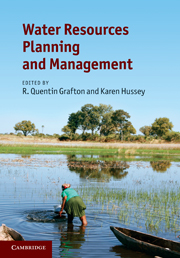Book contents
- Frontmatter
- Contents
- List of contributors
- Foreword
- Preface
- Acknowledgements
- Introduction
- Part I Understanding ‘water’
- Part II Water resources planning and management
- 8 Water law and the search for sustainability: a comparative analysis
- 9 Tackling the global water crisis: unlocking international law as fundamental to the peaceful management of the world's shared transboundary waters – introducing the H2O paradigm
- 10 Risk and uncertainty in water resources planning and management: a basic introduction
- 11 Collaboration and stakeholder engagement
- 12 Capacity building and knowledge sharing
- 13 Adaptive and integrated management of water resources
- 14 Gender and integrated water resource management
- 15 Environmental flows: achieving ecological outcomes in variable environments
- Part III Water resources planning and management: case studies
- Contributors
- Index
10 - Risk and uncertainty in water resources planning and management: a basic introduction
from Part II - Water resources planning and management
Published online by Cambridge University Press: 05 August 2011
- Frontmatter
- Contents
- List of contributors
- Foreword
- Preface
- Acknowledgements
- Introduction
- Part I Understanding ‘water’
- Part II Water resources planning and management
- 8 Water law and the search for sustainability: a comparative analysis
- 9 Tackling the global water crisis: unlocking international law as fundamental to the peaceful management of the world's shared transboundary waters – introducing the H2O paradigm
- 10 Risk and uncertainty in water resources planning and management: a basic introduction
- 11 Collaboration and stakeholder engagement
- 12 Capacity building and knowledge sharing
- 13 Adaptive and integrated management of water resources
- 14 Gender and integrated water resource management
- 15 Environmental flows: achieving ecological outcomes in variable environments
- Part III Water resources planning and management: case studies
- Contributors
- Index
Summary
The Unknown
As we know,
There are known knowns.
There are things we know we know.
We also know
There are known unknowns.
That is to say
We know there are some things
We do not know.
But there are also unknown unknowns,
The ones we don't know
We don't know.
Secretary of Defense Rumsfeld at Department of Defense news briefing, Washington, D.C., Feb. 12, 2002Introduction
All of us face risks and uncertainties in our lives. No less is it so for those responsible for planning and managing water resource systems. Their job is to provide the desired quantity and quality of water, at reasonable costs, when and where it is needed. They are asked to reduce the extent, and adverse impacts, of floods and droughts, and provide the water needed for a variety of purposes, some of which are conflicting, and at the same time satisfy environmental and ecological goals. They must do this in ways that will best meet society's needs for water now and into the future without knowing how much water will be available in the future and what the temporal and spatial demands for it will be.
Not only are supplies and demands variable and uncertain, this variability and uncertainty is changing in ways we cannot predict. And to add to all this complexity, we cannot predict with certainty many of the economic, environmental, ecological, and social impacts resulting from various system infrastructure design and operating policy decisions – that are made in an effort to meet these needs and demands of society and which themselves are changing in uncertain ways over time.
- Type
- Chapter
- Information
- Water Resources Planning and Management , pp. 230 - 250Publisher: Cambridge University PressPrint publication year: 2011
- 1
- Cited by

